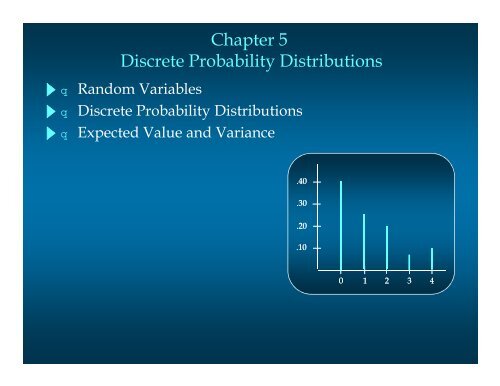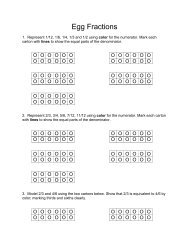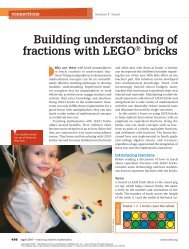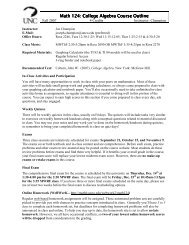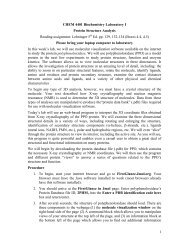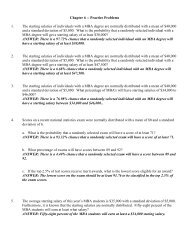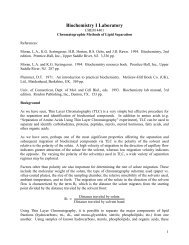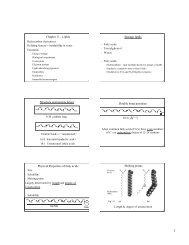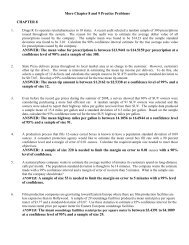PDF Version
PDF Version
PDF Version
You also want an ePaper? Increase the reach of your titles
YUMPU automatically turns print PDFs into web optimized ePapers that Google loves.
Chapter 5<br />
Discrete Probability Distributions<br />
■<br />
■<br />
■<br />
Random Variables<br />
Discrete Probability Distributions<br />
Expected Value and Variance<br />
.40<br />
.30<br />
.20<br />
.10<br />
0 1 2 3 4
Random Variables<br />
A random variable is a numerical description of the<br />
outcome of an experiment.<br />
A discrete random variable may assume either a<br />
finite number of values or an infinite sequence of<br />
values.<br />
A continuous random variable may assume any<br />
numerical value in an interval or collection of<br />
intervals.
Example: JSL Appliances<br />
■<br />
Discrete random variable with a finite number<br />
of values<br />
Let x = number of TVs sold at the store in one day,<br />
where x can take on 5 values (0, 1, 2, 3, 4)
Example: JSL Appliances<br />
■<br />
Discrete random variable with an infinite sequence<br />
of values<br />
Let x = number of customers arriving in one day,<br />
where x can take on the values 0, 1, 2, . . .<br />
We can count the customers arriving, but there is no<br />
finite upper limit on the number that might arrive.
Random Variables<br />
Question Random Variable x Type<br />
Family<br />
size<br />
Distance from<br />
home to store<br />
Own dog<br />
or cat<br />
x = Number of dependents<br />
reported on tax return<br />
x = Distance in miles from<br />
home to the store site<br />
x = 1 if own no pet;<br />
= 2 if own dog(s) only;<br />
= 3 if own cat(s) only;<br />
= 4 if own dog(s) and cat(s)<br />
Discrete<br />
Continuous<br />
Discrete
Discrete Probability Distributions<br />
The probability distribution for a random variable<br />
describes how probabilities are distributed over<br />
the values of the random variable.<br />
We can describe a discrete probability distribution<br />
with a table, graph, or equation.
Discrete Probability Distributions<br />
The probability distribution is defined by a<br />
probability function, denoted by f(x), which provides<br />
the probability for each value of the random variable.<br />
The required conditions for a discrete probability<br />
function are:<br />
f(x) > 0<br />
Σf(x) = 1
Discrete Probability Distributions<br />
■<br />
■<br />
Using past data on TV sales, …<br />
a tabular representation of the probability<br />
distribution for TV sales was developed.<br />
Number<br />
Units Sold of Days<br />
0 80<br />
1 50<br />
2 40<br />
3 10<br />
4 20<br />
200<br />
x f(x)<br />
0 .40<br />
1 .25<br />
2 .20<br />
3 .05<br />
4 .10<br />
1.00<br />
80/200
Discrete Probability Distributions<br />
■<br />
Graphical Representation of Probability Distribution<br />
.50<br />
Probability<br />
.40<br />
.30<br />
.20<br />
.10<br />
0 1 2 3 4<br />
Values of Random Variable x (TV sales)
Discrete Uniform Probability Distribution<br />
The discrete uniform probability distribution is the<br />
simplest example of a discrete probability<br />
distribution given by a formula.<br />
The discrete uniform probability function is<br />
f(x) = 1/n the values of the<br />
random variable<br />
are equally likely<br />
where:<br />
n = the number of values the random<br />
variable may assume
Expected Value and Variance<br />
The expected value, or mean, of a random variable<br />
is a measure of its central location.<br />
E(x) = μ = Σxf(x)<br />
The variance summarizes the variability in the<br />
values of a random variable.<br />
Var(x) = σ 2 = Σ(x - μ) 2 f(x)<br />
The standard deviation, σ, is defined as the positive<br />
square root of the variance.
Expected Value and Variance<br />
■<br />
Expected Value<br />
x f(x) xf(x)<br />
0 .40 .00<br />
1 .25 .25<br />
2 .20 .40<br />
3 .05 .15<br />
4 .10 .40<br />
E(x) = 1.20<br />
expected number of<br />
TVs sold in a day
Expected Value and Variance<br />
■<br />
Variance and Standard Deviation<br />
E(x) = 1.20<br />
x<br />
x - μ (x - μ) 2 f(x) (x - μ) 2 f(x)<br />
0<br />
1<br />
2<br />
3<br />
4<br />
-1.2<br />
-0.2<br />
0.8<br />
1.8<br />
2.8<br />
1.44<br />
0.04<br />
0.64<br />
3.24<br />
7.84<br />
.40<br />
.25<br />
.20<br />
.05<br />
.10<br />
.576<br />
.010<br />
.128<br />
.162<br />
.784<br />
Variance of daily sales = σ 2 = 1.660<br />
TVs<br />
squared<br />
Standard deviation of daily sales = 1.2884 TVs
Binomial Distribution<br />
■<br />
Four Properties of a Binomial Experiment<br />
1. The experiment consists of a sequence of n<br />
identical trials.<br />
2. Two outcomes, success and failure, are possible<br />
on each trial.<br />
3. The probability of a success, denoted by p, does<br />
not change from trial to trial.<br />
stationarity<br />
4. The trials are independent. assumption
Binomial Distribution<br />
Our interest is in the number of successes<br />
occurring in the n trials.<br />
We let x denote the number of successes<br />
occurring in the n trials.
Binomial Distribution<br />
■<br />
Binomial Probability Function<br />
n<br />
!<br />
x<br />
f ( x ) = p (1 −<br />
p<br />
)<br />
x !( n<br />
−<br />
x<br />
)!<br />
( n −<br />
x<br />
)<br />
where:<br />
f(x) = the probability of x successes in n trials<br />
n = the number of trials<br />
p = the probability of success on any one trial
Binomial Distribution<br />
■<br />
Binomial Probability Function<br />
n<br />
!<br />
x<br />
f ( x ) = p (1 −<br />
p<br />
)<br />
x !( n<br />
−<br />
x<br />
)!<br />
( n −<br />
x<br />
)<br />
n<br />
!<br />
x !( n<br />
−<br />
x<br />
)!<br />
Number of experimental<br />
outcomes providing exactly<br />
x successes in n trials<br />
x<br />
p (1 p )<br />
−<br />
( n x<br />
−<br />
)<br />
Probability of a particular<br />
sequence of trial outcomes<br />
with x successes in n trials
Binomial Distribution<br />
■<br />
Example: Evans Electronics<br />
Evans is concerned about a low retention rate for<br />
employees. In recent years, management has seen a<br />
turnover of 10% of the hourly employees annually.<br />
Thus, for any hourly employee chosen at random,<br />
management estimates a probability of 0.1 that the<br />
person will not be with the company next year.
Binomial Distribution<br />
■<br />
Using the Binomial Probability Function<br />
Choosing 3 hourly employees at random, what is<br />
the probability that 1 of them will leave the company<br />
this year<br />
f ( x<br />
)<br />
=<br />
Let: p = .10, n = 3, x = 1<br />
n<br />
!<br />
p<br />
x !( n<br />
−<br />
x<br />
)!<br />
x<br />
n x<br />
( p) ( −<br />
1−<br />
)<br />
3!<br />
f = = =<br />
1!(3 −<br />
1)!<br />
1 2<br />
(1) (0.1) (0.9) 3(.1)(.81) .243
Binomial Distribution<br />
■<br />
Using Tables of Binomial Probabilities<br />
p<br />
n<br />
x .05 .10 .15 .20 .25 .30 .35 .40 .45 .50<br />
3 0 .8574 .7290 .6141 .5120 .4219 .3430 .2746 .2160 .1664 .1250<br />
1 .1354 .2430 .3251 .3840 .4219 .4410 .4436 .4320 .4084 .3750<br />
2 .0071 .0270 .0574 .0960 .1406 .1890 .2389 .2880 .3341 .3750<br />
3 .0001 .0010 .0034 .0080 .0156 .0270 .0429 .0640 .0911 .1250
Binomial Distribution<br />
■<br />
Expected Value<br />
E(x) = μ = np<br />
■<br />
Variance<br />
Var(x) = σ 2 = np(1 − p)<br />
■<br />
Standard Deviation<br />
σ =<br />
np<br />
(1 −<br />
p<br />
)
Binomial Distribution<br />
■<br />
Expected Value<br />
E(x) = μ = 3(.1) = .3 employees out of 3<br />
■<br />
Variance<br />
Var(x) = σ 2 = 3(.1)(.9) = .27<br />
■<br />
Standard Deviation<br />
σ = 3(.1)(.9) =<br />
.52 employees


